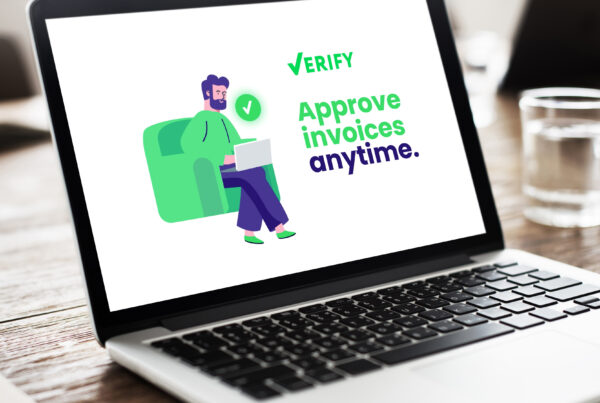The phrase “time is money” rings as true for the money you owe others as money you earn. In today’s “real-time” business environment, supplier invoices must be processed quickly and consistently. Failure to manage liabilities, knowing what you owe and when you need to pay, can kill your business just as quickly as a lack of customers.
If your business still operates a manual accounts payable process, you face an uphill struggle to keep up with today’s fast-paced business requirements. This is particularly true when delegating responsibilities to department managers and their reports across multiple sites.
To scale up a business with top-line revenue growth, you need effective expenditure and liability management to deliver bottom-line profit growth. The people and the resources necessary for growth bring new challenges in delegating expenditure control, requiring a clear delineation of responsibilities and business processes to align with that growth.
There is no room for inefficiency here. Without addressing it, the impact hits you exponentially as you grow. Slow invoice processing will result in suppliers being paid late and disruption to the supply chain. These are the last things you need when you want to grow your business, especially with new risks emerging like fraud. This may arise due to the wrong people approving invoices or staff purposefully changing supplier payment details.
We identify here some indicators of inefficiency and how to address them using automation to improve your accounts payable process.
What are the key indicators of an inefficient process?
These are six symptoms indicate that you may need to rethink how you process invoices:
- Your invoices go missing in action.
- Expenditure is often coded to the wrong accounts.
- Invoices are sent to the wrong office or person for approval and spend a lot of time in in-trays or in-transit between individuals.
- Staff spend a lot of their time responding to supplier enquiries about invoices. Once an invoice enters the accounts payable process it is not visible until it exits the process. Your staff are often requesting duplicates for suppliers.
- Staff spend all their time on data entry and have little time for value-added activities.
- Finding invoices that have been processed is time-consuming, and it isn’t easy to understand how they ended up being approved for payment.
There is often one more obvious symptom: you are not in control of the payments agenda, and suppliers are either paid late and/or on account when demanding payment. The latter was a significant issue at Patisserie Valerie: the interim Finance Director found it challenging to work out the liabilities due to the number of on account payments.
Diagnosis and solution
Diagnosis will often point to the invoice routing (workflow) stages of the process, i.e. when invoices are sent out for receipt and order checking, coding and approval. Different types of expenditure require different routing, which soon becomes very complex when a business operates at scale.
Also, diagnosis will often identify the lack of an up-to-date and visible authority register to determine who is responsible for what expenditure. In the worst case, this can be understood rather than documented, extended only by the assumption that x or y should be able to approve this.
Identity issues often accompany this, so for example, though everyone may know that Mr Jones signs off the marketing expenses, all his invoices are actually signed by his secretary Joan. If asked to identify Mr Jones’ signature, the accounting staff would show you the initials input on each invoice by Joan.
The proposed solution is to automate invoice processing.
No more lost invoices
By automating invoice routing, setting up the system defines the routing, and therefore staff no longer have to work out where an invoice should go next. Your invoices will automatically go directly to the staff responsible for completion per your approved process. Invoices are stored and transported in a digital format, enabling identification and access to the supporting documents at any stage in the process.
More reliable invoice coding
An automated process can filter the accounts to those relevant to the department or project, including suggesting where such expenditure has previously been coded. This reduces the risk of coding errors.
Those responsible for department or project expenditure can take ownership of the coding, reducing the risks that their accounts are misstated and helping them make decisions based on data they can trust.
Easy to follow authority register
An authority register in a business with many departments and/or projects can have many permutations and get complex very quickly. Automation moves this complexity to those responsible for setting up and maintaining the register and removes the need for staff to work out where the invoice should be sent for approval.
With automated solutions, users do not have to see the authority register at all. The invoice automatically follows the register, meaning employees will not have to spend more time and effort working out who is next in the process.
Automation removes the identity issues as only those staff responsible for approval receive the approval task.
Visibility of work in progress
Automated invoice processing solutions allow you to see exactly who has worked on an invoice, what actions they have taken, and who is next in the process. Users can also leave notes explaining why they did an action, such as sending invoices back to previous stages.
This allows you to respond in real time to supplier enquiries. The status of an invoice is always visible in the process.
Automatic data capture
Automated accounts payable systems should include a data capture function, which extracts the data required by the finance system when an invoice is received. The system sends the data and an image of the invoice to each staff member responsible for a task in the process. Invoices with multiple expenditure lines for different departments can be processed in parallel by each department, and once all expenditure is approved, the invoice is automatically posted to your ERP.
The finance team no longer spend their valuable time on mundane data entry. Instead, they can apply their skills to activities like exception handling and review and analysis, adding more value to the business.
Digital storage of invoices
An automated system should come with digital storage that has powerful search capabilities, enabling fast retrieval of the invoice data, image and audit trail. This makes all invoices quick and easy to find and access. The audit trail, including notes, should enable you to see the reasons why staff took specific actions.
Conclusion
In today’s fast-paced business environment, there is little room for inefficiency; time costs money and opportunities are lost.
Efficiency is essential but counts for little without control of each process and the result.
Control is key through both liability management, a key component of working capital management to maintain cash flow, and control of expenses to maintain profitability.
Both efficiency and control require visibility. To be fast and effective, it is necessary to have real-time visibility of the process and the transactions. The phrase “I’ll get back to you on that” can be the beginning of the end for your business in a market that expects information to be at your fingertips.



